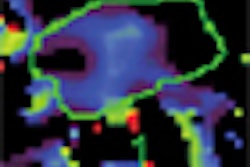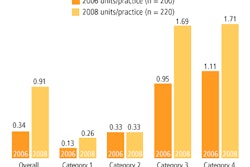Researchers who analyzed a large database of resected colon polyps concluded that the American College of Radiology's (ACR) policy of ignoring diminutive polyps detected at virtual colonoscopy could lead to as many as 30% of patients with "high-risk findings" being read as normal on VC exams.
An additional 18% to 23% of screening patients could be given the opportunity to undergo surveillance of polyps 6-9 mm in size for three years in lieu of polypectomy, delaying the resection of some high-risk adenomas.
"The majority of patients with high-risk adenoma findings who would go undetected using current CT colonography recommendations are patients with three or more adenomas," wrote Dr. Douglas Rex and colleagues from Indiana University Medical Center in Indianapolis. "The implications of failure to resect multiple small adenomas are unknown, and the importance of individual adenomas 5 mm in size is often assumed to be insignificant. However, postpolypectomy studies have shown that three or more adenomas, without reference to size, are the most consistent predictor of advanced adenomas being detected within three years" (American Journal of Gastroenterology, January 2009, Vol. 104, pp. 149-153).
Advanced histology is rare in polyps ≤ 5 mm, and such lesions are difficult to detect reliably at virtual colonoscopy (also known as CT colonography, or CTC). As a result, the Reston, VA-based ACR's guidelines recommend that polyps 5 mm or smaller in diameter not be reported at CTC or followed up with optical colonoscopy and polypectomy. Patients with one or two polyps 6-9 mm in size found at VC may be offered CTC surveillance at three years, the ACR's recommendations also state.
In their study, Rex and colleagues aimed to evaluate the impact of ACR recommendations on resection of high-risk adenoma findings in a large endoscopic polyp/histology database.
After excluding patients with inflammatory bowel disease and polyposis, 10,034 patients underwent colonoscopy and 10,780 polyps were removed from 5,079 patients over a five-year period, the researchers wrote. High-risk adenoma findings were defined as an advanced adenoma (1 cm in size, high-grade dysplasia, or villous elements) or three or more adenomas of any size, per postpolypectomy surveillance recommendations.
The results showed that 5,079 of the patients (51%) had at least one polyp, 2,907 (29%) had at least one adenoma, and 1,001 (10%) had high-risk adenoma findings. The high-risk findings included 293 (29%) patients with either three adenomas ≤ 5 mm in size (n = 267) or an advanced adenoma ≤ 5 mm in size (or both), without polyps of any histology ≥ 6 mm in size.
In medium-sized polyps, the researchers found 774 patients with either one or two polyps 6-9 mm in size who had no polyps of any histology ≥ 10 mm in size. Among these patients, 184 (18% of the patients with high-risk adenomas) had either three or more adenomas ≤ 9 mm (n = 149), an advanced adenoma ≤ 9 mm, or both findings.
Among the resected adenomas 5 mm or smaller, 0.87% were advanced adenomas and 0.05% contained invasive cancers, the group reported. Of the polyps ranging from 6-9 mm in diameter, 5.3% contained advanced adenomas and none had cancer.
Looking at the screening population of the cohort, high-risk adenoma findings were found in 326 (15%) of 2,174 patients ages 50 and older with primary screening indications. Of these, 108 (33%) had either three or more adenomas ≤ 5 mm in size (n = 267), an advanced adenoma ≤ 5 mm, or both.
Fifteen percent (n = 326) of the screening population had an advanced adenoma 5 mm or smaller, and an additional 75% had an advanced adenoma ≤ 5 mm without any polyp 6 mm or larger that would have triggered surveillance or a polypectomy referral, the authors noted.
"If ... (CTC) rather than colonoscopy were used in this population, assuming 100% sensitivity of CTC for polyps ≥ 6 mm and ACR interpretation recommendations, then ... 33% of screening patients age ≥ 50 years with high-risk adenoma findings would be interpreted as normal, and an additional 18% to 23% of these groups with high-risk adenoma findings, respectively, could have polypectomy delayed at least three years," Rex and colleagues wrote.
The findings are in line with other mostly smaller studies on the histology of resected polyps and, therefore, can be considered a fair representation of findings in daily practice, they wrote. In addition, since the study patients were examined from 1999 to 2004, the sensitivity of colonoscopy has improved with the implementation of high-definition optics, according to the authors. For the purposes of the study, VC's sensitivity was assumed to be 100% for polyps 6 mm and larger.
The researchers concluded that examining the patients in their cohort with virtual colonoscopy following ACR guidelines would have led to "half of patients with high-risk adenoma findings being reported as normal or near-normal, with polypectomy delayed by at least three years," they wrote. However, "because the natural history of adenomas ≤ 9 mm is incompletely understood, the full implications of the ACR recommendations for colorectal cancer prevention remain uncertain," they added.
In particular, the significance of three or more diminutive polyps is unknown, and further studies will be needed to address that issue, Rex and his team noted.
"Postpolypectomy studies have shown that three or more adenomas, without reference to size, are the most consistent predictor of advanced adenomas being detected within three years," they wrote. "However, it is unclear in the postpolypectomy surveillance literature whether detection of ≥ 3 adenomas, all of which are ≤ 5 mm in size, has the same implications for subsequent appearance of an advanced adenoma as detection of ≥ 3 adenomas, one or more of which is ≥ 6 mm in size."
Disputing the meaning
In an e-mail to AuntMinnie.com, Dr. Perry Pickhardt, associate professor of radiology at the University of Wisconsin School of Medicine in Madison, took issue with the authors' methodology.
"This paper is little more than a statistical trick, since cases with three or more adenomas are lumped together with the truly important subset of cases -- those with advanced adenomas," Pickhardt wrote. "Because advanced histology is so infrequent in subcentimeter polyps, the vast majority of these purportedly 'mismanaged' subsets are simply cases of diminutive or small tubular adenomas. There is no good evidence to suggest that several tiny tubular adenomas are an important independent risk factor, as the 'three or more adenoma' rule is largely driven by nondiminutive lesions. CTC has been shown to be equally effective (or better) for detecting advanced adenomas -- and can do it in a safer and more cost-effective manner than colonoscopy."
In a response via e-mail, lead investigator Rex said it was incorrect to call the paper a "statistical trick" as there were no statistics involved.
"The paper is purely descriptive and no attempt was made to hide the percentage of patients who had three or more small or diminutive adenomas versus those who had advanced adenomas -- the numbers in each group are displayed in full in the tables," he wrote.
The tables show that there were 104 (4.8%) patients 50 years and older with a primary screening indication who had no polyp 6 mm or larger, and three or more ≤ 5 mm polyps. An adjacent entry shows that there were 108 (5.0%) patients in that same subset of screening patients who had "three adenomas ≤ 5 mm or an advanced adenoma ≤ 5 mm or both," suggesting that two of the screening patients had an advanced adenoma ≤ 5 mm. The researchers found 79 advanced adenomas (including tubulovillous, villous, or high-grade dysplasia) and four cancers ≤ 5 mm in the entire study population.
Rex also took issue with Pickhardt's view that guidelines denoting the presence of three or more adenomas as high risk were driven by the risk of multiple adenomas 5 mm or larger rather than diminutive lesions.
"Guidelines do not distinguish the finding of 'three or more adenomas' as a high-risk factor based on the size of those adenomas," Rex wrote in his e-mail. "Indeed, the postpolypectomy literature has repeatedly identified three or more adenomas, without reference to their size, as the most consistent predictor of the subsequent (at follow-up colonoscopy) appearance of an advanced adenoma."
"Almost no studies have separated the group with three or more adenomas according to the size of those adenomas. In the discussion of the paper we reviewed this limitation of current knowledge, and I acknowledge its potential though unproven importance," Rex continued. "That does not change the accuracy of the paper with regard to the numbers of patients who according to current guidelines would have high-risk findings identified by endoscopists, but who would be called normal or might wait three years before polypectomy if they first underwent CTC."
By Eric Barnes
AuntMinnie.com staff writer
January 14, 2009
Related Reading
Model finds small polyp surveillance safe, cost-effective, November 4, 2008
Autopsy study confirms low prevalence of adenomas in youth, October 14, 2008
Highest colonoscopy screening rates are in low-risk patients, May 29, 2008
Model finds polyp surveillance effective for cancer prevention, January 21, 2008
Screening colonoscopy findings linked to incident lesions during surveillance, November 8, 2007
Copyright © 2009 AuntMinnie.com



















